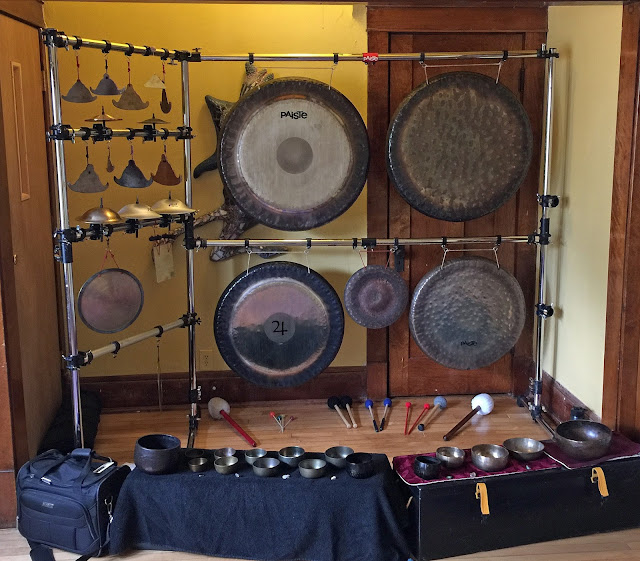Miking Your Gongs/Bells/Bowls In Larger Rooms - Part 3
Microphones. If you've been doing your research, you've come to know that there are literally hundreds and hundreds of choices. And the more you learn, the more you can make an informed choice about what to use.
OK, now let's assume you have picked out some mics, or have an idea of what you should use in any given situation. Now let's look at how to apply them.
A lot depends on your set up. If you use 1 Gong, it's very easy to just stick a mic there and amplifying the sound. And that's something you need to emphasize to whoever is running the sound reinforcement for you:
That means no effects, no fancy EQ, no added stuff except to amplify the volume to make it presentable to a large room. And with that, once levels are set, they need to be left alone so the Gong player can control their own volume by playing soft, loud, and anywhere in between. That means, when you play quietly, the sound person does not need to turn things up so that it can be louder, or heard better, because a lot of what we do is quiet and needs to be quiet.
Here is a typical mic set up for 1 Gong. Again, because this is not a rock concert, or a drum, there is no need to stick a mic right next to the Gong. Depending on the space we are in, and the acoustics of that space, the mic/s should be 1-2' away, or even more. What we want to do is pick up both the sound of the Gong, and the sound of the air/room around it. This is important, because the Gong/Bowl/Bell is all about the air. The sounds need to breathe, need to expand. Close miking gives you the sound of the Gong only, without the air. 1 mic behind, or above the Gong will capture both the sound and the air. Now if you use Bowls/Bells/other small percussion, you will want a 2nd mic for them, placed similarly near the instruments, or if you hold things up, placed accordingly so it will be aimed at where you hold things up.
Classic Miking Patterns
With 2 Gongs, 1 mic can also work, whether they are next to each other, or stacked on top of each other. But what about larger set ups with multiple Gongs? If your set up is still fairly compact, you may be fine with 2 overhead mics aimed in a classic XY pattern. Note: the XY set up as overheads can work well for most situations, whether 1 or 10 Gongs. A lot depends on how spread out things are, and how big the stage/set up area is.
An XY setup, either in front, or in front but up above, will capture the instruments and the air. Now if things are spread out, you may want to spread the 2 mics out further in an AB pattern.
Depending on how large a set up you have, you may want to use more than 2 mics. If you have multiple racks of Gongs, you may want 1 or 2 mics per rack, behind each rack. I have done this on numerous occasions when using my large set up. Since I'm not using monitor speakers*, I can easily have the mics behind the Gongs pointing towards the front of the stage, without worrying about feedback.
The above photo is from a clinic I presented at PASIC 2005 in Columbus, Ohio. This was in a 600 seat ballroom. From what I recall, there were 5 mics used: 3 behind the 3 Gong racks, 1 for the Kulintang (far right of the photo), and 1 speaking mic.
Be aware that the more mics you use, the more potential problems with feedback if you use monitors, and/or extraneous sounds coming through the mics.
OK, now let's assume you have picked out some mics, or have an idea of what you should use in any given situation. Now let's look at how to apply them.
A lot depends on your set up. If you use 1 Gong, it's very easy to just stick a mic there and amplifying the sound. And that's something you need to emphasize to whoever is running the sound reinforcement for you:
You only want to amplify the original acoustic sound.
That means no effects, no fancy EQ, no added stuff except to amplify the volume to make it presentable to a large room. And with that, once levels are set, they need to be left alone so the Gong player can control their own volume by playing soft, loud, and anywhere in between. That means, when you play quietly, the sound person does not need to turn things up so that it can be louder, or heard better, because a lot of what we do is quiet and needs to be quiet.
Single mic, single Gong
Here is a typical mic set up for 1 Gong. Again, because this is not a rock concert, or a drum, there is no need to stick a mic right next to the Gong. Depending on the space we are in, and the acoustics of that space, the mic/s should be 1-2' away, or even more. What we want to do is pick up both the sound of the Gong, and the sound of the air/room around it. This is important, because the Gong/Bowl/Bell is all about the air. The sounds need to breathe, need to expand. Close miking gives you the sound of the Gong only, without the air. 1 mic behind, or above the Gong will capture both the sound and the air. Now if you use Bowls/Bells/other small percussion, you will want a 2nd mic for them, placed similarly near the instruments, or if you hold things up, placed accordingly so it will be aimed at where you hold things up.
Classic Miking Patterns
With 2 Gongs, 1 mic can also work, whether they are next to each other, or stacked on top of each other. But what about larger set ups with multiple Gongs? If your set up is still fairly compact, you may be fine with 2 overhead mics aimed in a classic XY pattern. Note: the XY set up as overheads can work well for most situations, whether 1 or 10 Gongs. A lot depends on how spread out things are, and how big the stage/set up area is.
Depending on how large a set up you have, you may want to use more than 2 mics. If you have multiple racks of Gongs, you may want 1 or 2 mics per rack, behind each rack. I have done this on numerous occasions when using my large set up. Since I'm not using monitor speakers*, I can easily have the mics behind the Gongs pointing towards the front of the stage, without worrying about feedback.
Gong clinic at PASIC 2005
The above photo is from a clinic I presented at PASIC 2005 in Columbus, Ohio. This was in a 600 seat ballroom. From what I recall, there were 5 mics used: 3 behind the 3 Gong racks, 1 for the Kulintang (far right of the photo), and 1 speaking mic.
Be aware that the more mics you use, the more potential problems with feedback if you use monitors, and/or extraneous sounds coming through the mics.
* Since this article is about playing solo, the use of any monitors is generally not needed. When playing in a group situation, that becomes another matter entirely.While this series in some ways only scratches the surface of mics and miking techniques, I hope it has given you some place to start. Remember that often the simpler set up is the best one to use.
~ MB
Chop Wood | Carry Water | Play Gongs







Hallo Michael,
ReplyDeleteThanks for the interesting posts. I have still some questions because I am in the planning phase of some gong concerts (indoor as well as outdoor). I expect 10 to 12 32” gongs or bigger. How and how many microphones would you place for that outdoor event? Right now there will be different Meinl and Paiste single and double stands.
Cheers
Dirk
My apologies for not answering sooner.
DeleteOutdoors, I would use 1 mic behind each Gong if possible for the most control. If 2 Gongs are mounted on a double stand, one above the other, 1 mic between them can work well.
Indoors, you can possibly get away with fewer mics because the sound doesn’t dissipate like it does outdoors. If you are using 6 double stands, you could use 3 mics - 1 between 2 stands/4 Gongs. In a smaller room a stereo pair might be enough to just add a bit of volume & presence.
The 2 main factors are: how the Gongs are set up/spread out, and how big a room/stage.
I hope this helps. Let me know what you end up doing. Thanks.
Very helpful post, thanks. Recording a gong meditation tomorrow for a documentary film, with gong racks on opposite ends of the funkily shaped room. One musician, fortunately. Will experiment with some of these ideas during sound check. Will likely go with an omni LDC toward each end, between the racks, and perhaps two stereo pairs as well. Listening carefully during sound check will be my best friend
ReplyDeleteListening & experimenting are always your best bets. Walk around the space before hand and listen to where it sounds best, or sounds like you want to hear it. Place your mics there to start. Let me know how things work out.
Delete